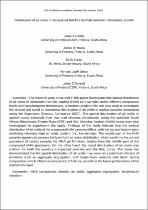 ResearchSpace
ResearchSpace
Distribution of air voids in compacted Hot-Mix Asphalt samples – laboratory vs field
JavaScript is disabled for your browser. Some features of this site may not work without it.
- ResearchSpace
- →
- Research Publications/Outputs
- →
- Conference Publications
- →
- View Item
| dc.contributor.author |
Komba, Julius J

|
|
| dc.contributor.author |
Maina, JM

|
|
| dc.contributor.author |
Horak, E

|
|
| dc.contributor.author |
Steyn, WJ

|
|
| dc.contributor.author |
O’Connell, Johannes S

|
|
| dc.date.accessioned | 2020-03-23T07:08:08Z | |
| dc.date.available | 2020-03-23T07:08:08Z | |
| dc.date.issued | 2019-10 | |
| dc.identifier.citation | Komba, J.J., Maina, J.M., Horak, E., Steyn, W.J. & O’Connell, J.S. 2019. Distribution of air voids in compacted Hot-Mix Asphalt samples – laboratory vs field. In: 12th Conference on Asphalt Pavements for southern Africa, Sun City, 13 - 16 October 2019 | en_US |
| dc.identifier.uri | https://www.capsa2019.co.za/provisional-technical-program/ | |
| dc.identifier.uri | http://hdl.handle.net/10204/11374 | |
| dc.description | Presented in: 12th Conference on Asphalt Pavements for Southern Africa, Sun City, 13 - 16 October 2019 | en_US |
| dc.description.abstract | The research work presented in this paper investigated the spatial distribution of air voids in compacted Hot-Mix Asphalt (HMA) core samples under different compaction levels and layer/briquette thicknesses. A medium-graded HMA mix was used to investigate the vertical and radial or diametrical distribution of air voids in asphalt samples compacted using the Superpave Gyratory Compactor (SGC). The spatial distribution of air voids in asphalt cores extracted from two road sections constructed using the standard South African Bituminous Treated Base (BTB) and High Modulus Asphalt (HiMA) mixes were also investigated to supplement the study. Findings of the study indicate that the vertical distribution of air voids of the compacted HMA samples differs, with the top and bottom parts exhibiting relatively high air voids content (i.e., low density). The middle part of the HMA samples appears to possess fairly uniform air voids distribution, which confirms the current procedure of coring samples for HMA performance testing from the middle part of the compacted HMA specimens. On the other hand, the radial distribution of air voids was uniform for both the gyratory compacted samples and the field cores. The study has demonstrated that the spatial distribution of air voids may serve as a potential indicator of problems such as aggregate segregation, and temperature variation with depth during compaction, which influence compaction efficiency, as well as the future performance of the asphalt mix layer. | en_US |
| dc.language.iso | en | en_US |
| dc.publisher | CAPSA | en_US |
| dc.relation.ispartofseries | Workflow;23072 | |
| dc.subject | Air voids | en_US |
| dc.subject | Aggregate segregation | en_US |
| dc.subject | Density | en_US |
| dc.subject | HMS Compaction | en_US |
| dc.subject | Temperature variation | en_US |
| dc.title | Distribution of air voids in compacted Hot-Mix Asphalt samples – laboratory vs field | en_US |
| dc.type | Conference Presentation | en_US |
| dc.identifier.apacitation | Komba, J. J., Maina, J., Horak, E., Steyn, W., & O’Connell, Johannes S (2019). Distribution of air voids in compacted Hot-Mix Asphalt samples – laboratory vs field. CAPSA. http://hdl.handle.net/10204/11374 | en_ZA |
| dc.identifier.chicagocitation | Komba, Julius J, JM Maina, E Horak, WJ Steyn, and O’Connell, Johannes S. "Distribution of air voids in compacted Hot-Mix Asphalt samples – laboratory vs field." (2019): http://hdl.handle.net/10204/11374 | en_ZA |
| dc.identifier.vancouvercitation | Komba JJ, Maina J, Horak E, Steyn W, O’Connell, Johannes S, Distribution of air voids in compacted Hot-Mix Asphalt samples – laboratory vs field; CAPSA; 2019. http://hdl.handle.net/10204/11374 . | en_ZA |
| dc.identifier.ris | TY - Conference Presentation AU - Komba, Julius J AU - Maina, JM AU - Horak, E AU - Steyn, WJ AU - O’Connell, Johannes S AB - The research work presented in this paper investigated the spatial distribution of air voids in compacted Hot-Mix Asphalt (HMA) core samples under different compaction levels and layer/briquette thicknesses. A medium-graded HMA mix was used to investigate the vertical and radial or diametrical distribution of air voids in asphalt samples compacted using the Superpave Gyratory Compactor (SGC). The spatial distribution of air voids in asphalt cores extracted from two road sections constructed using the standard South African Bituminous Treated Base (BTB) and High Modulus Asphalt (HiMA) mixes were also investigated to supplement the study. Findings of the study indicate that the vertical distribution of air voids of the compacted HMA samples differs, with the top and bottom parts exhibiting relatively high air voids content (i.e., low density). The middle part of the HMA samples appears to possess fairly uniform air voids distribution, which confirms the current procedure of coring samples for HMA performance testing from the middle part of the compacted HMA specimens. On the other hand, the radial distribution of air voids was uniform for both the gyratory compacted samples and the field cores. The study has demonstrated that the spatial distribution of air voids may serve as a potential indicator of problems such as aggregate segregation, and temperature variation with depth during compaction, which influence compaction efficiency, as well as the future performance of the asphalt mix layer. DA - 2019-10 DB - ResearchSpace DP - CSIR KW - Air voids KW - Aggregate segregation KW - Density KW - HMS Compaction KW - Temperature variation LK - https://researchspace.csir.co.za PY - 2019 T1 - Distribution of air voids in compacted Hot-Mix Asphalt samples – laboratory vs field TI - Distribution of air voids in compacted Hot-Mix Asphalt samples – laboratory vs field UR - http://hdl.handle.net/10204/11374 ER - | en_ZA |





